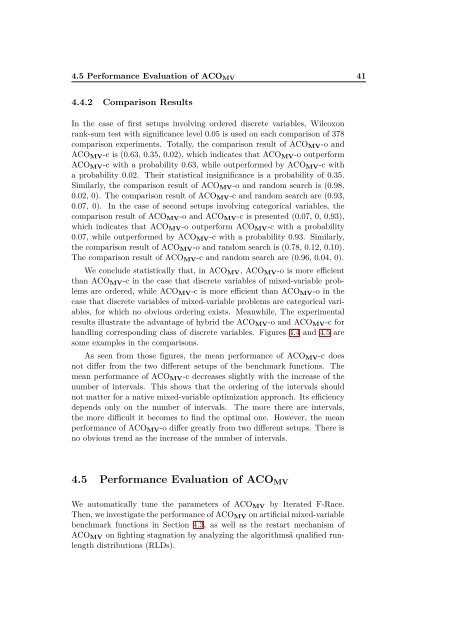Improved ant colony optimization algorithms for continuous ... - CoDE
Improved ant colony optimization algorithms for continuous ... - CoDE
Improved ant colony optimization algorithms for continuous ... - CoDE
You also want an ePaper? Increase the reach of your titles
YUMPU automatically turns print PDFs into web optimized ePapers that Google loves.
4.5 Per<strong>for</strong>mance Evaluation of ACOMV<br />
4.4.2 Comparison Results<br />
In the case of first setups involving ordered discrete variables, Wilcoxon<br />
rank-sum test with significance level 0.05 is used on each comparison of 378<br />
comparison experiments. Totally, the comparison result of ACOMV-o and<br />
ACOMV-c is (0.63, 0.35, 0.02), which indicates that ACOMV-o outper<strong>for</strong>m<br />
ACOMV-c with a probability 0.63, while outper<strong>for</strong>med by ACOMV-c with<br />
a probability 0.02. Their statistical insignificance is a probability of 0.35.<br />
Similarly, the comparison result of ACOMV-o and random search is (0.98,<br />
0.02, 0). The comparison result of ACOMV-c and random search are (0.93,<br />
0.07, 0). In the case of second setups involving categorical variables, the<br />
comparison result of ACOMV-o and ACOMV-c is presented (0.07, 0, 0.93),<br />
which indicates that ACOMV-o outper<strong>for</strong>m ACOMV-c with a probability<br />
0.07, while outper<strong>for</strong>med by ACOMV-c with a probability 0.93. Similarly,<br />
the comparison result of ACOMV-o and random search is (0.78, 0.12, 0.10).<br />
The comparison result of ACOMV-c and random search are (0.96, 0.04, 0).<br />
We conclude statistically that, in ACOMV, ACOMV-o is more efficient<br />
than ACOMV-c in the case that discrete variables of mixed-variable problems<br />
are ordered, while ACOMV-c is more efficient than ACOMV-o in the<br />
case that discrete variables of mixed-variable problems are categorical variables,<br />
<strong>for</strong> which no obvious ordering exists. Meanwhile, The experimental<br />
results illustrate the adv<strong>ant</strong>age of hybrid the ACOMV-o and ACOMV-c <strong>for</strong><br />
handling corresponding class of discrete variables. Figures 4.4 and 4.5 are<br />
some examples in the comparisons.<br />
As seen from those figures, the mean per<strong>for</strong>mance of ACOMV-c does<br />
not differ from the two different setups of the benchmark functions. The<br />
mean per<strong>for</strong>mance of ACOMV-c decreases slightly with the increase of the<br />
number of intervals. This shows that the ordering of the intervals should<br />
not matter <strong>for</strong> a native mixed-variable <strong>optimization</strong> approach. Its efficiency<br />
depends only on the number of intervals. The more there are intervals,<br />
the more difficult it becomes to find the optimal one. However, the mean<br />
per<strong>for</strong>mance of ACOMV-o differ greatly from two different setups. There is<br />
no obvious trend as the increase of the number of intervals.<br />
4.5 Per<strong>for</strong>mance Evaluation of ACOMV<br />
We automatically tune the parameters of ACOMV by Iterated F-Race.<br />
Then, we investigate the per<strong>for</strong>mance of ACOMV on artificial mixed-variable<br />
benchmark functions in Section 4.3, as well as the restart mechanism of<br />
ACOMV on fighting stagnation by analyzing the <strong>algorithms</strong>â qualified runlength<br />
distributions (RLDs).<br />
41

















